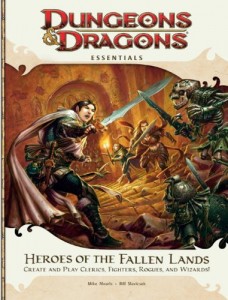Page 31 of Heroes of the Fallen Lands lists the classes that will be covered in this book – fighter, cleric, rogue, and wizard – but since we’ll cover these in more detail when we get to those chapters, I won’t linger on them now. Page 32, however, lists the classes and builds that will be available in Heroes of the Forgotten Kingdoms. This is practically an engraved invitation for us to speculate with insufficient data!
Druid, sentinel (leader): In past editions, druids had healing abilities as well as grabby-vines controller abilities, so I guess it’s nice that druids get a Leader build. I am interested to see how they avoid the CoDzilla problems of 3e, where clerics and druids could fill many party roles.
The Essentials druid is undoubtedly what Mma Ramotswe would call a “traditionally built” class, by which I mean a class with a regular pre-Essentials schedule of encounter and daily powers. Presumably these powers will all be interchangeable with druid powers from the PHB2 controller druid. What’s to stop a druid from cherrypicking both controller powers and leader powers?
Really, that’s the potential problem with any class which can cover different party roles. A good deal of a class’s ability to perform its role comes from class features. Many powers, however, bolster that role. For instance, imagine a defender class that had free access to cleric powers: sure, he wouldn’t have the Healing Word feature, but he’d have access to Recovery Strike, Healing Strike, and Beacon of Hope, and that’s just at level 1. He might be able to do a decent job in two roles.
On the other hand, covering multiple rolls with one class could be a good way to simulate multiclassing, while keeping the flavor of one unified class. So I could be a slayer (striker fighter) who takes some fighter utilities that help me mark an opponent, allowing me shoulder the role of defender from time to time, which is already a secondary role for my build.








